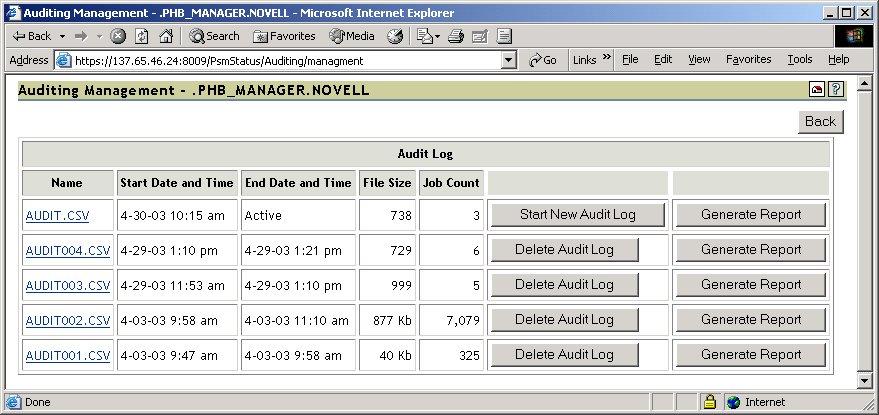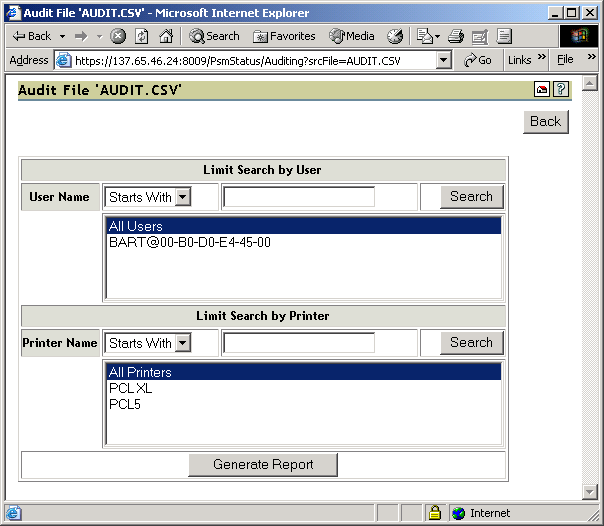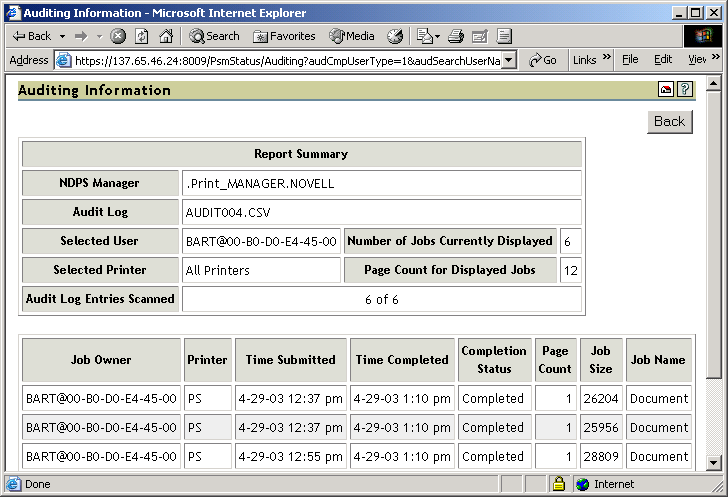Auditing Management Page

Although the default settings allow your users to print without further configuration being necessary, you will probably want to modify some of those settings so that you can manage your printing resources most effectively.
This section discusses the following:
The iPrint Manager uses a database to store information about the printers it controls. The database creates a backup when you create or delete a printer, and every night at midnight.
If the database fails to load through normal mechanisms, you can use the backup database by completing the following:
Rename var/opt/novell/iprint/psmdb.* to psmdbold.*.
Rename var/opt/novell/iprint/psmdbsav.* to psmdb.*.
Start the Print Manager.
When you create a Print Manager, a configuration file is created in /etc/opt/novell/iprint. The file name is print_manager_name.ipsmd.conf. A separate file is created for each Print Manager that is created and assigned to run on the same server. Only one Print Manager can run on the server at a time. For information about the entries in the configuration file, see /etc/opt/novell/iprint/ipsmd-template.conf.
The ipsmd.conf file links to the configuration file of the currently loaded Print Manager.
To load a different Print Manager on the server, use the Manage Print Manager > Manager Control page in iManager. If you attempt to load a Print Manager when one is already running, you will receive an error message instructing you to unload the current Print Manager before loading the new one.
If you need to change the eDirectoryTM server assignment for the iPrint Manager or iPrint Driver Store, edit the DSServer1= entry in the corresponding configuration file located in /etc/opt/novell/iprint/.
NOTE: Up to two additional servers can be specified using DSServer2 and DSServer3. DSServer1 is considered the primary eDirectory server, whereas DSServer2 and DSServer3 are considered secondary servers.
The iPrint Manager Health Monitor provides administrators with a global view of their print system. The Health Monitor shows you the current status of the iPrint Manager and the associated printers and lets you configure error threshold, customize some print system settings, and generate reports about your system. The following tasks are reviewed in this section:
The iPrint Manager Health Monitor is a powerful tool to manage and troubleshoot your print system. The following examples show some of the features and information available in the Health Monitor. The opening page of the Health Monitor shows all of your printers, their current state, and general statistics including the number of print jobs printed in the last hour, in the last day, and since the iPrint Manager was last started.
A quick look at these statistics will help you identify which printers are not printing due to errors or are not being used. By clicking a printer name, you can see additional details about the printer that can help you troubleshoot a reported printer error and why users are not using a printer.
For example, if the printer status shows Error printing, then click the printer for a list of known problems. If one of the known problems is Printer not connected, then use the IP address listed in the Load String field to ping the printer to determine if the IP address is valid.
By looking at the statistical information, you can correct printer problems or make decisions about redeploying underused printers to departments that print a lot.
The Health Monitor can be accessed by entering the following URL: https://server_address/psmstatus, where server_address is the IP address or DNS name of the server where the iPrint Manager is running.
You can view current Printer Agent states, start up and shut down Printer Agents, and view other information about your print system.
The report feature of the Health Monitor allows you to generate a report that can be displayed on the page or saved as a comma-separated-value (CSV) file that can be used in a spreadsheet program.
On the iPrint Manager Health Monitor main page, click Advanced iPrint Manager Information > Generate Report.
(Optional) To save the report as a file, click Write Results to File under the File Options heading.
The heading will specify the location and file name of the report.
Select the information you want included in the report by checking the corresponding check boxes.
Click Generate report.
The report is displayed on the screen, even if you selected to save the report to a file.
You can configure settings in the Health Monitor to control how the Health Monitor presents information when certain thresholds are met.
On the iPrint Manager Health Monitor main page, click Advanced iPrint Manager Information > Configure Settings and Error Thresholds.
Adjust the settings you want to change.
See the online help for more information about the available settings. For most print systems, the default settings are sufficient.
Suppose a printer has been taken offline and sent to the manufacture for repairs, but you keep getting phone calls from other administrators that the printer has an error in the Health Monitor. This can be resolved by leaving a message about the printer in Health Monitor. Users can see the message, but only administrators can edit it.
On the iPrint Manager Health Monitor main page, click the printer you want and then click Message from Admin.
Type the text you want displayed for this printer.
Click Apply.
To remove a message, follow the steps above but delete the text in Step 2.
You can create a pool of printers to share the load of printing. Users install one of the printers in the pool. When a printer in the pool has a print job waiting, the iPrint Manager can redirect that print job to an idle printer in the pool. The iPrint Manager attempts to evenly distribute print jobs among all printers in a pool. For example, if four printers are in the pool and the first printer is printing a 100-page job, then the next print job will be sent to the second printer. If the second printer completes the print job and the first printer is still busy, the next print job will be sent to the third printer to distribute print jobs throughout the pool. Printer pools are specific to the iPrint Manager, and a printer pool cannot span multiple iPrint Managers.
Printers that are included in a pool should be the same model and use the same printer drivers. You can include only printers from the same iPrint Manager in a pool.
When you create a printer pool, the pool information resides in the iPrint Manager and can be viewed only using Novell iManager. Unlike the printers and the iPrint Manager, a separate eDirectory object for a printer pool is not created.
After you set up a printer pool, users install only one of the printers in the pool on their workstation. When a user submits a print job to the installed printer, the iPrint Manager uses the method above to send the print job to the next available printer in the pool. Users should be reminded that their print jobs might be printed by any printer in the pool. For this reason, the physical printers that are members of a printer pool should be located close to one another. You might also want to enable banner pages, depending on the type of documents being printed.
To set up printer pooling:
In Novell iManager, click iPrint > Printer Pool Configuration.
Select the Print Manager for this pool.
Select Create Pool from the Select an Operation list, then click OK.
Specify the name of the printer pool.
This name is used to identify the pool only within Novell iManager.
Select the printers you want included in the pool.
Click Next.
To modify or delete a pool, follow the above steps and select the desired action from the Select an Operation list in Step 3.
First you need to enable auditing for each printer you want to audit using Novell iManager or the iPrint Manager Health Monitor.
In Novell iManager, click iPrint > Manage Printer.
Browse to and select the printer you want to enable auditing for.
Click Configuration > Auditing.
Check the Enable Auditing check box.
From a Web browser, load and log in to the iPrint Manager Health Monitor by entering https://server_address/psmstatus.
Click Configuration Options.
Check the Enable Auditing check box.
When auditing is enabled for a Printer Agent, a log file is created indicating who printed how many pages to which printer on a given date. The log file is in a comma-separated format (CSV). The data from this log file can be viewed from the Health Monitor, or downloaded into a spreadsheet. To access the Health Monitor, enter the following in a Web browser:
http://iPrint_Manager_URL/psmstatus
For example:
http://printing.mycompany.com/psmstatus
Figure 7
Auditing Management Page
From the Auditing Management page, you can complete the following tasks:
You can generate an audit report that shows all print jobs, or you can filter the report based on a user or a printer or both.
In the iPrint Manager Health Monitor, click Advanced iPrint Manager Information > Auditing > Generate Report.
If there is more than one audit log, click Generate Report for the audit log you want to view.
(Optional) Filter the search by using the Limit Search by User or Limit Search by Printer filters.
Figure 8
Auditing Generate Report Page
Click Generate Report to view the report with the specified filters.
Only 250 print jobs are listed at a time. To view more print jobs in the report, click Next.
Figure 9
Auditing Report
The following table explains the fields that are displayed under the Report Summary.
The following table discusses what is displayed in the body of the report.
You can manage your audit logs by using the displayed buttons on the Audit page. When audit logs are no longer needed, you can delete them. On a daily, weekly, or monthly basis, you might want to save the current data in the audit.csv file into a separate audit log to keep the log file more manageable.
The active audit log file (audit.csv) logs data for all printers that have been enabled for auditing. You can generate a report from this file or you can move the data to a saved file using Start New Audit Log. You cannot download the audit.csv file. To download a file, it must be saved as a separate audit log. When you move the data to a saved audit log using the Start New Audit Log button, the log file is named auditxxx.csv, where xxx is the next sequential number of the log. After a log file is saved, you can download the file to your workstation and import it into a spreadsheet program.
When the file is downloaded, you can open the report in a spreadsheet application to sort, view, and format the data to meet your needs. The active audit log, audit.csv, cannot be downloaded. You must first start a new audit log by clicking Start New Audit Log, then download the newly created audit log.
On the iPrint Manager Health Monitor main page, click Advanced iPrint Manager Information > Auditing.
Right-click the name of the audit log you want to download, then click Save Target As.
Follow the prompts and save the file to the desired location.
An iPrint Manager must be created as an object in the eDirectory tree before you can create and associate Printers. An iPrint Manager provides a platform for Printer Agents, a logical representation of printers that reside on the server. You can manually load iPrint Manager on a server.
Use the following guidelines to determine where and when to place an iPrint Manager:
Ensure that you have the Supervisor right for the container where the iPrint Manager object will reside.
In iManager click iPrint > Create Print Manager.
Fill in the fields.
Click Help for explanations about the fields.
(Optional) Leave the Start Print Manager after Creation check box checked.
If another Print Manager is already loaded and you check this checkbox, you will receive an error message that the Print Manager was created but not loaded. To load the new Print Manager, you must first unload the currently running Print Manager.
Click OK.
After the Print Manager is created, the daemon is loaded on the server.
To modify the iPrint Manager properties, click Manage iPrint Manager and then select the Manager you want to modify.
For a discussion of Access Control roles, see Setting Access Control for Your Print System.
The iPrint Manager uses a Linux Standards Base (LSB) init script for starting and stopping the daemon. To load the iPrint Manager from the command line, enter /etc/init.d/novell-ipsmd start. The following init script actions are also valid:
| Action | Description |
|---|---|
start |
Starts the daemon |
stop |
Stops the daemon |
reload or force-reload |
Stops and then starts the daemon |
status |
Displays the status of the daemon and the name of the iPrint Manager. |
On the Manager Control Property page, you can view the Print Manager's status and unload or load the manager daemon.
In Novell iManager, click iPrint > Manage Print Manager.
Browse to and select the Print Manager you want to control.
Click Manager Control > Shutdown to stop iPrint Manager.
Click OK.